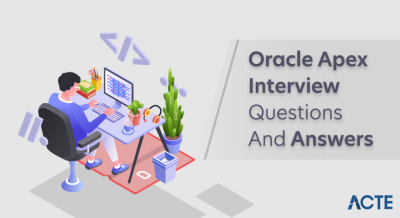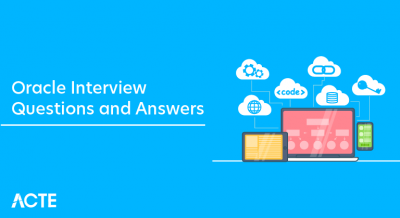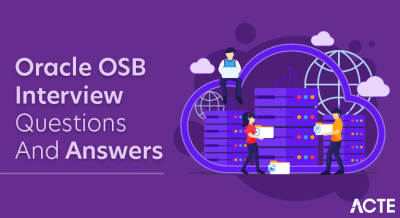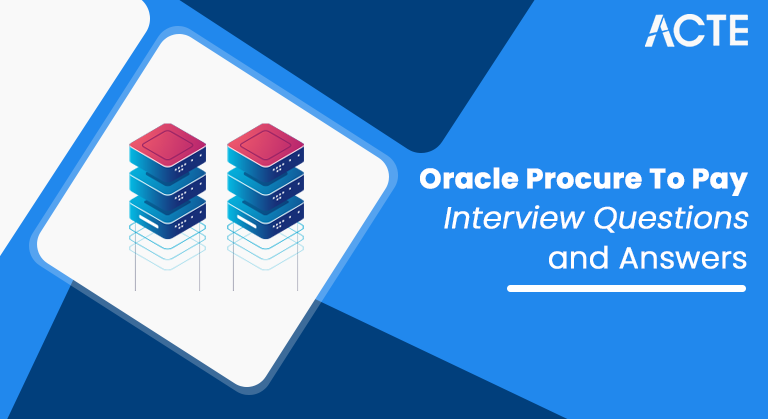
Are you planning to attend an interview for the Oracle P2P role but confused on how to crack that interview and also what would be the most probable P2P Interview Questions that the interviewer may ask? Well, you have reached the right place. ACTE has collected the most frequently asked Oracle Procure to Pay Interview Questions which are often asked in multiple interviews.
1. Explain the key modules in Oracle Procure-to-Pay.
Ans:
- Purchasing: Manages the procurement process from requisition to purchase order.
- Procurement: Enables employees to create requisitions and manage their procurement needs.
- Payables: Handles invoice processing, payment processing, and expense management.
- Cash Management: Manages cash flow and bank reconciliation.
2. What is the purpose of Oracle Procurement Contracts?
Ans:
Oracle Procurement Contracts facilitates creating, managing, and tracking procurement agreements and contracts. It ensures that organizations have legally binding agreements with their suppliers, defining terms and conditions for procuring goods and services.
3. Explain the concept of blanket purchase orders in Oracle Purchasing.
Ans:
Blanket Purchase Orders (BPOs) in Oracle Purchasing are long-term agreements that enable organizations to procure goods or services at predefined prices over a specified period. They simplify repetitive purchasing, reduce paperwork, and provide flexibility in managing ongoing procurement needs.
4. What are some common challenges in implementing Oracle Procure-to-Pay, and how can they be mitigated?
Ans:
Common challenges include data migration issues, user resistance, and system customization complexities. These challenges can be mitigated through thorough planning, effective change management, and engaging in best practices for system implementation.
5. How does Oracle Procurement support supplier relationship management?
Ans:
- Oracle Procurement provides tools for supplier qualification, performance evaluation, and collaboration.
- It allows organizations to establish strong relationships with their suppliers, leading to better negotiation, improved service levels, and overall supplier satisfaction.
6. Can you explain the three-way matching concept in Oracle Payables?
Ans:
Three-way matching involves comparing the purchase order, receipt, and invoice to ensure that the quantities, prices, and terms align. Oracle Payables automates this process, helping organizations identify discrepancies and provide accurate and timely payments.
7. How does Oracle Sourcing contribute to the procurement process?
Ans:
- Oracle Sourcing facilitates the negotiation and awarding of contracts to suppliers.
- It enables organizations to conduct online negotiations, request quotations (RFQs), and reverse auctions, optimizing the sourcing process and achieving cost savings.
8. What is the purpose of Oracle Self-Service Procurement?
Ans:
Oracle Self-Service Procurement allows employees to independently create requisitions, check the status of their orders, and manage their procurement needs. It promotes user autonomy and reduces the workload on the procurement department.
9. How does Oracle Procurement Cloud differ from the on-premise Oracle E-Business Suite?
Ans:
- Oracle Procurement Cloud is a cloud-based solution offering scalability, flexibility, and ease of updates.
- In contrast, the on-premise Oracle E-Business Suite requires local infrastructure and periodic manual updates. Cloud solutions generally provide faster implementation and reduced maintenance efforts.
- Oracle Procurement Cloud and the on-premise Oracle E-Business Suite are both solutions offered by Oracle, but they differ in deployment models, architecture, and some functional aspects.
| Oracle Procurement Cloud | On-premise Oracle E-Business Suite |
|---|---|
| Cloud-based | On-premise |
| Accessible via the internet | Typically accessed within the organization’s network |
| Managed by Oracle on cloud infrastructure | Requires on-premise servers and IT infrastructurek |
10. Discuss the integration points between Oracle Procurement and Oracle Inventory.
Ans:
- Oracle Procurement integrates with Oracle Inventory to ensure accurate tracking of goods. When goods are received, the inventory is updated accordingly, providing real-time visibility into stock levels and aiding in effective inventory management.
- These two modules are part of the larger Oracle E-Business Suite, and their integration ensures that procurement activities are closely tied to inventory management.
11. What are the key considerations when migrating from a legacy procurement system to Oracle Procure-to-Pay?
Ans:
Considerations include data migration, system customization, user training, and change management. A well-planned migration strategy should address these aspects to ensure a smooth transition without disruptions to daily operations.
12. How does Oracle Procure-to-Pay contribute to cost savings for organizations?
Ans:
Oracle P2P contributes to cost savings through various means, including
- Process Automation: Automation of procurement processes reduces manual effort and associated errors.
- Supplier Management: Effective supplier management helps negotiate better terms and discounts.
- Streamlined Procurement: Efficient procurement processes lead to faster cycle times and reduced administrative costs.
- Compliance Management: Ensures adherence to procurement policies and compliance with regulations.
13. What is the significance of the Oracle Supplier Portal in the Procure-to-Pay process?
Ans:
Oracle Supplier Portal is a self-service platform that allows suppliers to interact with the buying organization. Suppliers can manage their information, submit bids, view purchase orders and invoices, and communicate with the buying organization through the portal. This enhances collaboration, reduces manual communication, and provides real-time visibility into buyer and supplier procurement transactions.
14. Why is timely payment necessary for the vendor?
Ans:
Timely payment is crucial for vendors for several reasons. It significantly impacts the overall health of the vendor-client relationship and the vendor’s ability to conduct business efficiently.
15. Mention some benefits of Oracle procure to pay that you are familiar with.
Ans:
- Oracle P2P provides seamless integration across the procurement process, ensuring a holistic and unified approach from requisitioning to payment.
- The suite optimizes procurement workflows, reducing manual intervention and streamlining processes.
- Oracle P2P facilitates collaboration with suppliers through a user-friendly interface.
- The platform provides real-time visibility into procurement data, supplier performance, and financial metrics.
16. What exactly do you know about the purchasing process?
Ans:
The purchasing process, or the procurement process, is a systematic series of steps organizations follow to acquire goods, services, or works from external sources.
- Invoice recording
- Goods receipt
- Paying to the vendors
- Acknowledgment of purchase
17. What is the critical Procure to Pay Cycle stage?
Ans:
- Identification of suppliers
- Negotiation (if possible)
- Purchase request authorization
- Record of invoice
- Shipment notice in advance
- Timely payment to the supplier
- Purchase request approval
18. How does Oracle handle Purchase Orders (POs) in the Procure-to-Pay Cycle?
Ans:
Oracle provides a comprehensive suite of applications to manage the Procure-to-Pay (P2P) cycle, and handling Purchase Orders (POs) is a critical part of this process. The Oracle Procure-to-Pay cycle typically involves several modules within the Oracle E-Business Suite or Oracle Cloud Applications.
- Requisitioning
- Document Approval
- Supplier Management
- Approval Workflow
19. What is the role of Oracle Receivables in the P2P process?
Ans:
It is a module within Oracle E-Business Suite or Oracle Cloud Applications that primarily focuses on managing the Order-to-Cash (O2C) process. While Procure-to-Pay deals with the purchasing side of business operations, and Order-to-Cash handles the sales and revenue collection aspects.
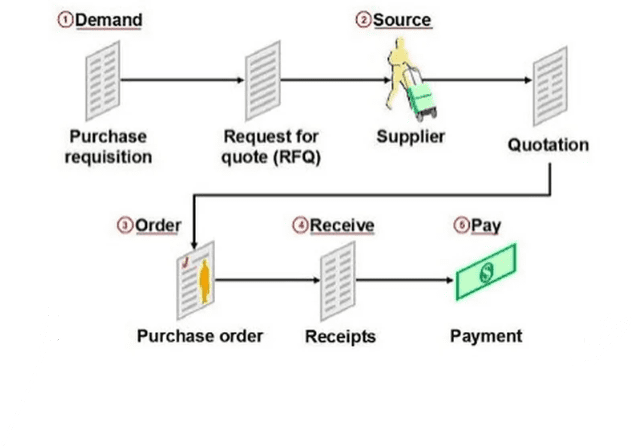
20. What is the role of Oracle Purchasing in the P2P process?
Ans:
It is a crucial module within the broader Oracle E-Business Suite and Oracle Cloud Procurement solutions. Here are the primary roles and functionalities of Oracle Purchasing in the P2P process:
- Receipt and Inspection
- Document Tracking and Visibility
- Sourcing Integration
- Purchase Order Generation
- Supplier Relationship Management
- Approval Workflows
- Requisition Management
21. Explain the purpose of Oracle Payables in P2P.
Ans:
The primary purpose of Oracle Payables in the P2P process is to manage and facilitate the payment of invoices generated from procurement activities. Oracle Payables manages the payment process, including invoice validation, payment creation, and maintaining supplier information.
22. How does Oracle Procure-to-Pay integrate with other Oracle modules?
Ans:
- Oracle Procure-to-Pay integrates seamlessly with modules such as Oracle Inventory, Oracle General Ledger, and Oracle Projects to provide a holistic view of the procurement process.
- Integration with various modules ensures smooth data flow, consistency, and accuracy across business processes.
23. How does Oracle handle three-way matching in the Payables module?
Ans:
Oracle Payables performs three-way matching by comparing the purchase order, receipt, and invoice to ensure that the quantities, prices, and terms match before processing the payment. Three-way matching is a crucial process in accounts payable that involves comparing three key documents before approving a supplier invoice for payment.
24. What challenges might you encounter in implementing Oracle Procure-to-Pay?
Ans:
Challenges may include data migration, user training, and integration with existing systems. Addressing these challenges involves careful planning, effective communication, and providing adequate training and support to end-users. Addressing these challenges requires careful planning, collaboration, and a proactive approach.
25. Explain the Procure-to-Pay process in Oracle.
Ans:
- The Procure-to-Pay process in Oracle typically involves creating purchase requisitions, converting them into purchase orders, receiving goods or services, matching invoices with purchase orders, and finally, processing payments.
- The Procure-to-Pay (P2P) process in Oracle involves a series of integrated steps that cover the entire procurement lifecycle, from requisitioning goods or services to making payments to suppliers.
26. What is a Purchase Order in Oracle Procure-to-Pay?
Ans:
Purchase Order (PO) is a document issued by a buyer to a seller, indicating types, quantities, and agreed prices for products or services. In Oracle Procure-to-Pay, POs are generated from approved purchase requisitions. The Purchase Order serves as a legal contract between the buyer and the supplier, outlining the specific terms and conditions of the transaction.
27. How does Oracle handle three-way matching in Procure-to-Pay?
Ans:
Oracle supports three-way matching, which involves matching the purchase order, receipt, and invoice. If all three match, the system allows the payment to be processed. Oracle Procure-to-Pay handles three-way matching as part of the accounts payable process to ensure accuracy in payments by comparing three key documents:
- The Purchase Order (PO)
- The Goods Receipt (GR)
- The Supplier Invoice
28. What is a Purchase Requisition in Oracle Procure-to-Pay?
Ans:
- Purchase Requisition (PR) is a formal request to procure goods or services. In Oracle, users create purchase requisitions to initiate the procurement process. Once
- approved, these requisitions can be converted into purchase orders. It serves as the starting point of the procurement process, outlining the details of what needs to be purchased and providing essential information for further procurement activities.
29. How does Oracle handle supplier management in Procure-to-Pay?
Ans:
Oracle Procure-to-Pay includes features for supplier management, allowing organizations to maintain supplier information, evaluate performance, and collaborate with suppliers for improved efficiency and collaboration.
30. What is the importance of Approval Hierarchies in Oracle Procure-to-Pay?
Ans:
- Approval hierarchies are crucial in Oracle Procure-to-Pay (P2P) by defining the workflow and authorization structure for various procurement processes.
- Approval Hierarchies in Oracle Procure-to-Pay define the sequence of approvers for purchase requisitions and purchase orders.
- They ensure the necessary approvals are obtained before proceeding with the procurement process.
31. Explain the role of Oracle Payables in the Procure-to-Pay process.
Ans:
- Oracle Payables is a part of the Procure-to-Pay process that manages the payment of invoices. It integrates with other modules to ensure accurate and timely payment processing based on approved invoices.
- Oracle Payables plays a crucial role in the Procure-to-Pay (P2P) process by managing the financial aspects of procurement transactions, explicitly focusing on the payment to suppliers.
32. What is a Purchase Order (PO) in Oracle Procure-to-Pay?
Ans:
Purchase Order is a document created in the Purchasing module that authorizes the purchase of goods or services. It includes details such as items to be purchased, quantities, prices, and terms.
33. Explain the Invoice Matching process in Oracle Payables.
Ans:
- Invoice Matching compares the purchase order, receipt, and invoice to ensure they match before payment.
- It helps prevent overpayment or payment for goods or services not received.
- This three-way matching process is designed to verify that an organization pays for goods or services it has ordered and received.
34. Explain the concept of three-way matching in Oracle Procure-to-Pay.
Ans:
Three-way matching involves comparing three documents – the purchase order, receipt, and invoice – to ensure consistency and accuracy. It helps verify that the goods or services were received as per the purchase order and that the invoice matches the received items.
35. How does Oracle Procure-to-Pay support supplier relationship management?
Ans:
- Oracle Procure-to-Pay (P2P) provides robust support for Supplier Relationship Management (SRM) by offering comprehensive features and functionalities that facilitate effective collaboration and management of relationships with suppliers.
- Oracle Procure-to-Pay supports supplier relationship management by providing tools for supplier collaboration, performance evaluation, and communication. It helps organizations build and maintain strong relationships with their suppliers.
36. What challenges may you encounter in Oracle Procure-to-Pay implementation?
Ans:
Common challenges include data migration issues, user resistance, and system integration complexities. Addressing these challenges involves thorough planning, user training, and stakeholder collaboration. Having a well-defined implementation strategy and engaging with experienced consultants is essential.
37. Explain the key components of Oracle Procure-to-Pay.
Ans:
- The key components include:
- Oracle Purchasing: Manages the procurement process, including purchase orders and approvals.
- Oracle iSupplier Portal: Enables collaboration between buyers and suppliers.
- Oracle Inventory: Manages inventory levels and controls stock.
- Oracle Payables: Handles invoice processing and payment.
38. What is a Purchase Order in Oracle Procurement?
Ans:
- A Purchase Order (PO) is a document issued by a buyer to a supplier, indicating the types, quantities, and agreed prices for products or services. In Oracle Procurement, a PO is created using the Oracle Purchasing module. It is a critical component of the
- Procure-to-Pay process and provide detailed information about the items or services being ordered, quantities, prices, delivery terms, and other relevant terms and conditions.
39. How does Oracle handle the three-way match in Procure-to-Pay?
Ans:
Oracle Procure-to-Pay performs a three-way match by comparing the purchase order, receipt, and invoice. If these three documents match, the system can automatically proceed with payment. This ensures that the correct goods are received at the agreed-upon price before payment.
40. Explain the concept of Approval Hierarchy in Oracle Procure-to-Pay.
Ans:
Approval Hierarchy in Oracle Procure-to-Pay defines the sequence in which purchase orders or requisitions are sent for approval. It ensures that the appropriate individuals review and approve documents based on predefined rules, such as monetary limits or departmental requirements.
41. What is Oracle Payables, and how does it integrate with other modules?
Ans:
Oracle Payables manages the invoice and payment processes. It integrates with Oracle Purchasing to receive invoices, Oracle Inventory for accounting entries related to inventory transactions, and Oracle General Ledger for financial reporting.
42. Explain the purpose of the Oracle iSupplier Portal.
Ans:
- Oracle iSupplier Portal is a self-service portal for suppliers. It allows them to view and acknowledge purchase orders, submit invoices electronically, and track payment status.
- It facilitates collaboration between buyers and suppliers, improving communication and efficiency in the procurement process.
43. How does Oracle Procure-to-Pay contribute to cost control?
Ans:
Oracle Procure-to-Pay provides features such as approval workflows, three-way matching, and budget controls. These functionalities help organizations control costs by ensuring that purchases are authorized, accurate, and within budgetary constraints.
44. How can organizations ensure data security in Oracle Procure-to-Pay?
Ans:
- Organizations can implement role-based access controls, encryption, and regular security audits.
- Oracle Procure-to-Pay also provides features to restrict access to sensitive information and monitor user activities.
45. How does Oracle P2P handle Purchase Orders (POs)?
Ans:
Purchase orders contain details such as the items or services to be procured, quantities, prices, and supplier information. They serve as a contractual agreement between the buyer and the supplier.
46. What is Oracle Self-Service Procurement?
Ans:
- Oracle Self-Service Procurement is a module that allows employees to create and manage their requisitions directly.
- It empowers users to initiate the procurement process without direct involvement from the procurement team, streamlining the requisitioning process.
- This module provides a user-friendly and intuitive interface, allowing employees to request and purchase goods and services while adhering to organizational procurement policies.
47. What is the purpose of a Purchase Requisition in Oracle Procure-to-Pay?
Ans:
A purchase requisition is a formal request to purchase goods or services. It is the initial step in the procurement process, indicating the need for specific items. The primary purpose of a Purchase Requisition is to streamline and formalize the internal request and approval process for procurement activities.
48. Explain the difference between a Standard and Blanket Purchase Order.
Ans:
- Standard Purchase Order: Used for one-time purchases with a specific quantity and delivery date.
- Blanket Purchase Order: Used for recurring purchases over a period, with multiple releases against the same order.
49. What is Three-Way Matching in Oracle Procure-to-Pay?
Ans:
Three-way matching in Oracle Procure-to-Pay is a crucial process that ensures accuracy and integrity in financial transactions by reconciling three key documents: Purchase Order (PO), Goods Receipt (GR), and Supplier Invoice. This matching process is designed to verify that an organization is paying for goods or services that were adequately ordered, received, and invoiced.
50. How does Oracle Procure-to-Pay handle Supplier Invoices?
Ans:
Oracle Procure-to-Pay allows users to enter and match supplier invoices to purchase orders and receipts. The system validates the three-way match before approving the invoice for payment. The handles supplier invoices as part of the broader procurement process, specifically in the Oracle Payables module.
51. Explain the concept of Self-Service Procurement in Oracle.
Ans:
- Self-service procurement enables employees to create purchase requisitions, search for and select items from catalogs, and submit requisitions for approval without direct involvement from the purchasing department.
- The concept revolves around providing a user-friendly and intuitive interface that enables employees to request and purchase goods and services without heavy reliance on the procurement department.
52. How does Oracle Procure-to-Pay support integration with other modules or systems?
Ans:
Oracle Procure-to-Pay can integrate with other Oracle modules, such as Oracle Inventory, Oracle Accounts Payable, and Oracle General Ledger. It also supports integration with external systems through various interfaces and APIs.This integration ensures seamless data flow, consistent processes, and real-time information sharing across different business functions
53. How does Oracle Purchasing support the procurement process?
Ans:
Oracle Purchasing supports procurement by managing requisitions, generating purchase orders, and communicating with suppliers. It also provides tools for buyer negotiations and contract management. It provides a comprehensive set of tools and functionalities to streamline and manage the entire procurement lifecycle, from requisitioning to payment.
54. What is the purpose of Oracle Sourcing?
Ans:
Oracle Sourcing is a part of Oracle Procurement that facilitates negotiating agreements and contracts with suppliers. It includes features like online bidding, RFQs (Request for Quotation), and negotiation capabilities.
55. How does Oracle Procurement integrate with other Oracle applications?
Ans:
- Oracle Procurement integrates with other Oracle applications such as Oracle Inventory, Oracle Order Management, and Oracle General Ledger to ensure a seamless flow of information across the supply chain and financial processes.
- Oracle Procurement is designed to integrate seamlessly with various other Oracle applications, creating a unified ecosystem that enables organizations to streamline business processes and enhance overall efficiency.
56. How does Oracle handle supplier information in Procure-to-Pay?
Ans:
Oracle Procure-to-Pay includes Supplier Management functionality, storing and managing supplier information such as contact details, performance evaluations, and payment terms. This information is critical for making informed procurement decisions, managing supplier relationships effectively, and maintaining compliance with contractual and regulatory requirements.
57. What is Oracle Purchasing, and how does it streamline procurement processes?
Ans:
Oracle Purchasing is a module that automates the procurement process by allowing organizations to create and manage purchase orders, track supplier performance, and optimize purchasing decisions. It streamlines procurement by providing a centralized platform for managing requisitions, approvals, and supplier relationships.
58. What is Oracle Payables, and how does it integrate with other modules in P2P?
Ans:
- Oracle Payables is a module that manages the payment process by handling invoices, expense reports, and supplier payments.
- It integrates with P2P modules such as Purchasing and iProcurement to ensure a seamless flow of information from procurement to payment.
59. What is Oracle Sourcing, and how does it contribute to the procurement process?
Ans:
- Oracle Sourcing is a module that facilitates the negotiation and sourcing of goods and services. It allows organizations to create and manage sourcing events, negotiate with suppliers, and select the best sources for procurement.
- It is designed to facilitate the sourcing of goods and services, supplier negotiations, and the selection of suppliers based on predefined criteria.
60. How does Oracle Procurement Contracts contribute to the procurement process?
Ans:
- Oracle Procurement Contracts enables the creation, management, and tracking of procurement contracts.
- It ensures that legal terms and conditions are adhered to in procurement transactions, providing a standardized approach to managing contracts.
- This module contributes significantly to procurement by offering tools and functionalities to create, manage, and enforce contracts.
61. What are some key benefits of implementing Oracle Procure-to-Pay?
Ans:
Some key benefits include improved efficiency in procurement processes, better visibility into spending, increased collaboration with suppliers, reduced cycle times, and enhanced control over procurement activities.
- End-to-End Automation
- Improved Efficiency
- Cost Savings
- Enhanced Visibility and Transparency
- Strategic Sourcing
- Improved Supplier Collaboration
62. How does Oracle handle the creation of Purchase Orders?
Ans:
Purchase Orders (POs) in Oracle are created through the Oracle Purchasing module. Users can create standard purchase orders, blanket purchase agreements, or contract purchase agreements. Purchase orders can be manually entered or automatically generated from approved requisitions. Creating POs involves converting approved requisitions or responding to sourcing events (such as RFQs) into formal purchase documents.
63. How does Oracle Supplier Management benefit organizations?
Ans:
Oracle Supplier Management helps organizations manage their supplier relationships more effectively. It provides:
- Tools for evaluating supplier performance.
- Tracking supplier qualifications.
- Ensuring compliance with contractual agreements.
This helps organizations make informed decisions about their suppliers.
64. Explain the concept of Encumbrance in Oracle Procure-to-Pay.
Ans:
Encumbrance in Oracle Procure-to-Pay refers to reserving funds when a purchase order or requisition is approved. It allows organizations to track and manage committed funds before goods or services are received and invoiced. This helps in budgetary control and financial planning.
65. What is the purpose of Oracle Accounts Payable (AP)?
Ans:
Oracle Accounts Payable is a module that manages the financial aspect of the Procure-to-Pay process. It includes functionalities like invoice processing, payment processing, and expense report management. AP ensures accurate and timely payment to suppliers while maintaining financial controls.
66. How does Oracle handle the approval process in Procure-to-Pay?
Ans:
- Oracle Procure-to-Pay includes a robust approval workflow for purchase requisitions, orders, and invoices.
- The approval process is configurable and can be tailored to the organization’s requirements.
- Approvers can review and approve transactions based on predefined rules and hierarchies.
67. What is the purpose of the Purchasing module in Oracle Procure-to-Pay?
Ans:
The Purchasing module in Oracle Procure-to-Pay (P2P) plays a central role in the procurement process by providing tools and functionalities to manage the purchasing lifecycle. Here are the essential purposes of the Purchasing module in Oracle Procure-to-Pay:
- Requisition to Purchase Order Conversion
- Approval Workflow
- Supplier Performance Tracking
- Receipt Processing
- Budgetary Controls
68. How does Oracle handle supplier collaboration in the Procure-to-Pay process?
Ans:
Oracle provides the iSupplier Portal module for supplier collaboration. It allows suppliers to access and update their information, submit bids, acknowledge purchase orders, and provide real-time status updates on deliveries and invoices.
69. Explain the role of procurement in Oracle Procure-to-Pay.
Ans:
Procurement is a self-service module that enables employees to create requisitions for goods and services. It streamlines the procurement process by allowing users to browse catalogs, create shopping lists, and submit requisitions for approval. It is designed to streamline and simplify the procurement workflow while maintaining control and compliance with organizational policies.
70. How do Oracle Procurement Contracts support the Procure-to-Pay process?
Ans:
Oracle Procurement Contracts helps manage and authorize contracts related to procurement. It ensures that the terms and conditions agreed upon with suppliers are appropriately documented and adhered to throughout the procurement process. It helps organizations create, manage, and enforce contracts with their suppliers.
71. Explain the importance of analytics in Oracle Procure-to-Pay.
Ans:
Procure-to-Pay Intelligence provides analytics and reporting capabilities, offering insights into procurement performance. It helps organizations make data-driven decisions, monitor key performance indicators, and optimize procurement processes.
72. How does Oracle handle integrating other systems in the Procure-to-Pay process?
Ans:
- Oracle Procure-to-Pay can be integrated with other Oracle applications and third-party systems using various integration tools and technologies, such as Oracle Integration Cloud.
- This ensures seamless data flow and process automation across different parts of the organization.
73. What are some best practices for implementing Oracle Procure-to-Pay?
Ans:
Best practices for implementing Oracle Procure-to-Pay include:
- Thoroughly understanding and documenting business processes.
- Engaging critical stakeholders throughout the implementation.
- Providing comprehensive training to end-users.
- Regularly review and optimize the configuration based on feedback and evolving business needs.
74. Explain the procure-to-pay cycle in Oracle.
Ans:
The procure-to-pay cycle involves creating a requisition, converting it into a purchase order, receiving the goods or services, matching the receipt with the purchase order and invoice, and finally, processing the payment.
75. How does Oracle Purchasing help in managing suppliers?
Ans:
Oracle Purchasing allows for creating and managing supplier information, negotiating agreements, and evaluating supplier performance through features such as Supplier Qualification Management.
76. What is Oracle Payables, and how does it streamline invoice processing?
Ans:
- Oracle Payables manages the invoice processing and payment to suppliers.
- It streamlines the process by automating invoice validation, approval workflows, and payment generation.
77. How does Oracle Procure-to-Pay support compliance and control?
Ans:
Oracle Procure-to-Pay enforces compliance with organizational policies and regulatory requirements by providing configurable approval workflows, audit trails, and security controls. It helps organizations maintain visibility and control over their procurement processes.
78. What is the role of Oracle Inventory in the procure-to-pay process?
Ans:
- Oracle Inventory manages the receipt, storage, and tracking of goods.
- It ensures that the physical inventory aligns with the information in the system and supports accurate financial reporting.
79. How can organizations leverage Oracle Procure-to-Pay for cost savings?
Ans:
Organizations can achieve cost savings through better negotiation with suppliers, efficient procurement processes, reduced manual errors, optimized inventory levels, and taking advantage of early payment discounts.
80. How does Oracle Procure-to-Pay integrate with other modules in Oracle E-Business Suite?
Ans:
Oracle Procure-to-Pay integrates with modules such as Oracle Inventory, Oracle Accounts Payable, and Oracle General Ledger to provide a seamless end-to-end procurement process.
81. What is the purpose of Purchase Requisitions in Oracle Procure-to-Pay?
Ans:
- Purchase requisitions are requests for goods or services made by internal departments.
- They initiate the procurement process by providing details on what needs to be purchased.
- A purchase requisition is a formal request from an employee or department within an organization to acquire goods or services.
82. How does Oracle Procure-to-Pay contribute to cost control in an organization?
Ans:
Oracle Procure-to-Pay helps control costs by enforcing procurement policies, optimizing supplier relationships, preventing overpayments through invoice matching, and providing insights into spending patterns. Oracle P2P helps streamline processes, enforce compliance, and optimize spending by providing a comprehensive procurement tool suite.
83. How does Oracle Procure-to-Pay handle approval workflows for purchase requisitions and orders?
Ans:
- Oracle Procure-to-Pay provides configurable approval workflows for purchase requisitions and purchase orders. These workflows can be designed to match an organization’s specific approval hierarchy and business rules.
- Oracle Procure-to-Pay (P2P) includes robust approval workflows for purchase requisitions and purchase orders to ensure that procurement transactions follow the established organizational processes and policies.
84. Explain the Blanket Purchase Agreements (BPAs) concept in Oracle Procure-to-Pay.
Ans:
Blanket Purchase Agreements are long-term agreements with suppliers that define the terms and conditions for recurring purchases over a specified period. They help streamline the procurement process for repetitive transactions.BPAs are particularly useful when there is an ongoing need for repetitive purchases over a specified period, and the exact quantities or delivery schedules may vary.
85. How does Oracle Procure-to-Pay handle requisitions?
Ans:
Requisitions are created in Oracle Procure-to-Pay to initiate the procurement process. Requisitions are requests made by employees or departments within an organization to acquire goods or services. They are then approved, and a Purchase Order is generated upon approval.
86. What is Oracle Sourcing in the context of Procure-to-Pay?
Ans:
Oracle Sourcing is a component that helps organizations identify potential suppliers, negotiate with them, and create agreements. It streamlines the sourcing process and facilitates better collaboration between buyers and suppliers. It provides a platform for organizations to efficiently manage and optimize their sourcing processes, including negotiating and selecting suppliers for goods and services.
87. How can you ensure compliance and control in Oracle Procure-to-Pay?
Ans:
Oracle Procure-to-Pay provides features such as approval workflows, document matching, and audit trails to ensure compliance with internal policies and control over the procurement process.
88. Can you explain the critical components of Oracle Purchasing?
Ans:
Oracle Purchasing, a key component within the Oracle E-Business Suite, is designed to streamline and automate the procurement process. It encompasses various features and functionalities that facilitate purchasing activities’ creation, management, and control. Here are the critical components of Oracle Purchasing:
- Requisitioning
- Supplier Management
- Purchase Orders
- Approval Workflow
- Request for Quotation (RFQ)
89. How does Oracle Payables contribute to the Procure-to-Pay process?
Ans:
Oracle Payables manages the payment process, including invoice validation, payment processing, and accounting. It integrates with other modules to ensure accurate and timely payment to suppliers. It is a crucial module within the Oracle E-Business Suite that focuses on processing supplier invoices, making payments, and ensuring compliance with financial regulations.
90. How can you handle exceptions in the Procure-to-Pay process using Oracle applications?
Ans:
Oracle applications provide exception handling through workflow notifications. For example, if there is a discrepancy in the three-way match, the system can generate a workflow notification for the appropriate personnel to resolve the issue. Oracle applications offer several tools and features to help organizations identify, manage, and resolve exceptions in the P2P process.
91. What is Oracle Approval Management’s (AME) significance in the Procure-to-Pay process?
Ans:
Oracle AME defines and manages approval rules in the procurement process. It allows organizations to customize approval hierarchies based on their business requirements, ensuring proper authorization for purchase transactions.
92. What is the purpose of the Oracle Purchasing (PO) module?
Ans:
The Purchasing module in Oracle facilitates the creation of purchase orders, managing supplier information, and controlling the procurement process. It includes features like requisitioning, purchase orders, and supplier management.
93. What is Oracle Payables, and how does it handle invoice processing?
Ans:
- Oracle Payables manages the payment process by handling invoices, expense reports, and payments.
- It validates invoices, matches them with purchase orders and receipts, and generates supplier payments.
- It provides a comprehensive set of tools and features to streamline and automate the processing of invoices, payments, and other financial transactions.
94. How does Oracle Cash Management integrate with Oracle Payables?
Ans:
Oracle Cash Management integrates with Oracle Payables to reconcile payments and bank statements. It helps manage cash flow, ensure accurate accounting, and reconcile bank transactions with payments made through Payables. The integration between Oracle Cash Management and Oracle Payables enables seamless handling of payment transactions, reconciliation, and overall financial management.
95. How does Oracle Procure-to-Pay contribute to better financial control?
Ans:
Oracle Procure-to-Pay provides better financial control by enforcing approval workflows, ensuring three-way matching, and integrating with financial modules. This results in accurate financial reporting and helps organizations manage their budgets effectively.
96. Explain the importance of Supplier Management in Oracle Procure-to-Pay.
Ans:
Organizations must manage suppliers efficiently to optimize costs, ensure product and service quality, mitigate risks, and foster strong and mutually beneficial supplier relationships. Here are vital aspects highlighting the importance of Supplier Management in Oracle Procure-to-Pay:
- Initiating Procurement Process
- Specification of Requirements
- Authorization and Approval
- Collaborative Relationships
- Strategic Sourcing
- Supplier Segmentation
97. What are Procurement Contracts in Oracle Procure-to-Pay?
Ans:
Procurement Contracts are legal agreements between the buying organization and the supplier. Procurement Contracts are designed to help organizations create, manage, and track various types of contracts, including agreements with suppliers, service providers, or other business partners. This module plays a crucial role in ensuring that contractual obligations are met, risks are mitigated, and compliance with negotiated terms is maintained throughout the procurement lifecycle
98. Explain the integration points of Oracle Procure-to-Pay with other Oracle applications.
Ans:
Oracle Procure-to-Pay integrates with Oracle Inventory, Oracle General Ledger, Oracle Receivables, and other relevant modules to provide a seamless end-to-end process. Integration points enable data flow and process coordination across different modules within the Oracle suite
99. How does Oracle Procure-to-Pay support compliance with regulatory requirements?
Ans:
- Oracle Procure-to-Pay includes features such as approval workflows, audit trails, and document management to support compliance with regulatory requirements. It helps organizations adhere to industry-specific regulations and internal policies.
- Oracle Procure-to-Pay (P2P) includes features and functionalities that support organizations in achieving and maintaining compliance with regulatory requirements. Compliance in procurement is critical for adhering to industry regulations, internal policies, and legal standards.
100. How does Oracle Procure-to-Pay contribute to cost control in organizations?
Ans:
Oracle Procure-to-Pay provides organizations with tools to monitor and control costs throughout the procurement process. This includes budget controls, approval workflows, and visibility into spending patterns, helping organizations optimize their procurement spend.

